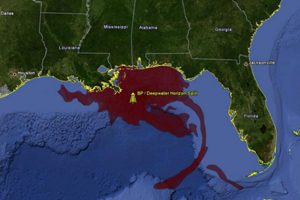
Deepwater Horizon Oil Spill Continues To Threaten The Ecology. Two weeks after the Deepwater Horizon oil rig exploded in the Gulf of Mexico, a massive oil spill continues to threaten the ecology and economy of the U.S. Gulf Coast. The ever-growing oil slick now measures approximately 130 miles by 70 miles – about the size […]

Deepwater Horizon Oil Spill Continues To Threaten The Ecology. Two weeks after the Deepwater Horizon oil rig exploded in the Gulf of Mexico, a massive oil spill continues to threaten the ecology and economy of the U.S. Gulf Coast. The ever-growing oil slick now measures approximately 130 miles by 70 miles – about the size of the state of Delaware. Four states – Louisiana, Mississippi, Alabama, and Florida – are under threat from the spill.
According to Reuters, BP, which was leasing Deepwater Horizon from TransOcean LTD, has reported some progress slowing the flow of oil from the leaking well. Crews in Louisiana have finished building the first of three massive steel and concrete containment domes the company plans to lower in place over one of the three leaks on the ocean floor. BP expects to load the dome aboard a ship tomorrow for transport to the site.
BP also has started drilling a relief well that could cap the oil spill, but that effort will take up to three months to complete, Reuters said.
TampaBay.com is reporting that BP was unable to install a shutoff valve at the site of one of the leaks due to rough seas. Heavy winds also damaged miles of floating booms laid out in coastal waters to protect the shoreline from the spreading oil slick. According to the TampaBay.com report, the slick appeared to be drifting toward the Alabama and Florida coasts and the Chandeleur Islands off Louisiana’s southern tip.
There are fears that the slick could be caught up in the Gulf Loop Current. That could carry the oil as far south as the Florida Keys and back up the east coast into the Atlantic.
For now, tGulf LoopOne positive note, however, is that stormy weather, which has slowed cleanup and containment, is expected to clear, and better conditions are expected over the next few days.
BP continues to face scrutiny because of the oil spill. Yesterday, the Obama Administration reiterated that the oil company would pay for the disaster. According to Reuters, Attorney General Eric Holder also made comments that seemed to indicate the disaster could eventually be the subject of a criminal probe.
BP acknowledged yesterday that it was “absolutely responsible” for stopping the leak, cleaning up the oil on the water’s surface and any resulting environmental damage. Some experts have put BP’s potential liability at more than $14 billion.
BP is also faced new accusations that it did not do enough to prevent the Deepwater Horizon explosion. The U.K’s Sunday Times reported that the oil company was warned 10 years ago about problems with the type of blowout preventer that led to the disaster. The blowout preventer should close an out-of-control well, but failed on Deepwater Horizon.
According to the Sunday Times, in 2000 TransOcean acknowledged that the blowout preventer on another rig – Discover Enterprise – did “not work exactly right”. BP had issued a “notice of default” to TransOcean over the problem that June, and the equipment was unable to operate for extended periods while it was fixed. The blowout preventer on Deepwater Horizon was fitted at about the same time BP was complaining of problems with its sister vessel, the Sunday Times said.
The New York Times also reported that lawyers for a worker who was on Deepwater Horizon at the time of the April 20 explosion had charged that the rig was drilling deeper than 22,000 feet, even though the company’s federal permit allowed it to go only to 18,000-20,000 feet deep. BP denies the claim.
The personal injury attorneys at Parker Waichman LLP offer free, no-obligation case evaluations. For more information, fill out our online contact form or call 1-800-YOURLAWYER (1-800-968-7529).


